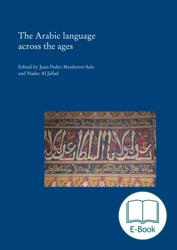“The Arabic language across the ages” provides a collection of linguistic and philological studies that investigate diachronically and chronologically different aspects of the Arabic language and its dialects. It presents studies on Arabic dialectology (e.g., Arabic North-African dialects), morphology (e.g., The Arabic plural), lexicology and lexicography (e.g., culinary lexicon), phonetics and phonology (e.g., vocalization), syntax (e.g., the function of the particle bi-), sociolinguistics (e.g. A lexical atlas of the Arab world), and history (e.g., dialects of Arabic before and after Classical Arabic).
“The Arabic language across the ages” represents a significant contribution to Arabic linguistics and philology. The book provides a variety of studies that address different aspects of the Arabic language. Some of the contributions are diachronic, focusing on the status quo of the language while others explore its history and development. It also provides text-analysis as well as geographical-based studies. Moreover, the relationship between Arabic and other languages is underlined.
More specifically, the book presents studies on Arabic dialectology (e.g., Arabic North-African dialects), morphology (e.g., The Arabic plural), lexicology and lexicography (e.g., culinary lexicon), phonetics and phonology (e.g., vocalization), syntax (e.g., the function of the particle bi-), sociolinguistics (e.g. A lexical atlas of the Arab world), and history (e.g., dialects of Arabic before and after Classical Arabic).
The present book is intended to be the first of a forthcoming series of publications on different aspects of the Arabic language, history and culture. The topics addressed offer a balanced treatment of the Arabic of today and the Arabic of the past.
The book can be of great interest for linguists of Arabic, the students of Arabic as a native language or a foreign language, professors and students at departments of Semitic studies, Islamic studies and Middle Eastern studies at all universities. It can be also of interest for scholars studying the history and culture of the Arab world. Needless to say, general linguists may find some of the linguistic issues addressed quite relevant and of universal significance (e.g., Arabic broken plural).
Dialectologists and researchers interested in language varieties will, undoubtedly, find some of the studies quite interesting since some understudied historical and current dialects of Arabic are investigated. This specific aspect of Arabic linguistics offers infinite number of research possibilities due to the diglossic relationship between Modern Standard Arabic or Classical Arabic and its various dialects as well as the rich variety of dialects spoken throughout the Arab World.
The contributions presented in this book are simply eye opening, whetting our appetite for more. They definitely demonstrate that the Arabic language is still almost a virgin field of study, providing various research ideas to pursue.
„Ce volume atteint sans conteste son but. Il atteste du dynamisme de la linguistique arabe en Esapgne, qui cepentant, comme le reste de <école> espagnole, demeure attachée prioritairement, sur le plan historique, à l’Andalousie et, sur le plan géographique, à son environnement immédiat, le Maghreb.“
Pierre Larcher
In: Wiener Zeitschrift für die Kunde des Morgenlandes (2012). Band 102 S. 396-399.
--------------------------
“In particular, the volume aims at providing new empirical data and theoretical insights emerging from Arabic dialectology and the study od primary sources (Middle Arabic included). In sodoing, this book proposes to radically rethink the diachronic study of Arabic, which seems to have neglected so far these two research areas, as F. Corriente points out in his contribution (ch. 1), which sketches out the state-of-the-art of the discipline. This integrated approach diachrony - dialects- primary sources serves as the unifying theme for the diversde contributions oth the volume and represents its most salient feature - as well as its added value.
Such an approach makes the volume suitabel for a broad audience of specialists, which encompasses historical linguists of Arabic, its dialectologists and philologists, and even Semitists. The scholars interested in this work, however, shoul be eager to accept the unorthodox viewpoints that its innovative approach implies.”
Francesco Grande
In: Quaderni di Studi Arabi. Nuova Serie 5-6 (2010-2011). S. 260-261.
Nader Al Jallad
Place of Birth: Jordan
PHD: Linguistics (January/2002)
University of Delaware, Newark, Delaware, USA
ACADEMIC APPOINTMENTS
Professor of Arabic linguistics, Department of Translation, University of Cordoba, Spain (Sept. 2009 - Present)
Professor of Arabic, UCOIDIOMA (The University of Cordoba Language Center), University of Cordoba, Spain (Feb. 2008 - June 2010)
Professor of English, Department of English, University of Jordan, Amman, Jordan (Feb. 2002 - June 2008)
Instructor, Department of Linguistics, University of Delaware, Newark, Delaware, USA (2000 - 2002)
Instructor, University Writing Center, University of Delaware, Newark, Delaware, USA (September/1999 - July/2000)
Instructor, English Language Institute, University of Delaware, Newark, Delaware, USA (Summer/2000 & Summer/2001)
ADMINISTRATIVE APPOINTMENTS
Assistant Dean for Development, Faculty of Arts, University of Jordan, Amman, Jordan (Feb. 2004 - June 2008)


 Inhalt
Inhalt